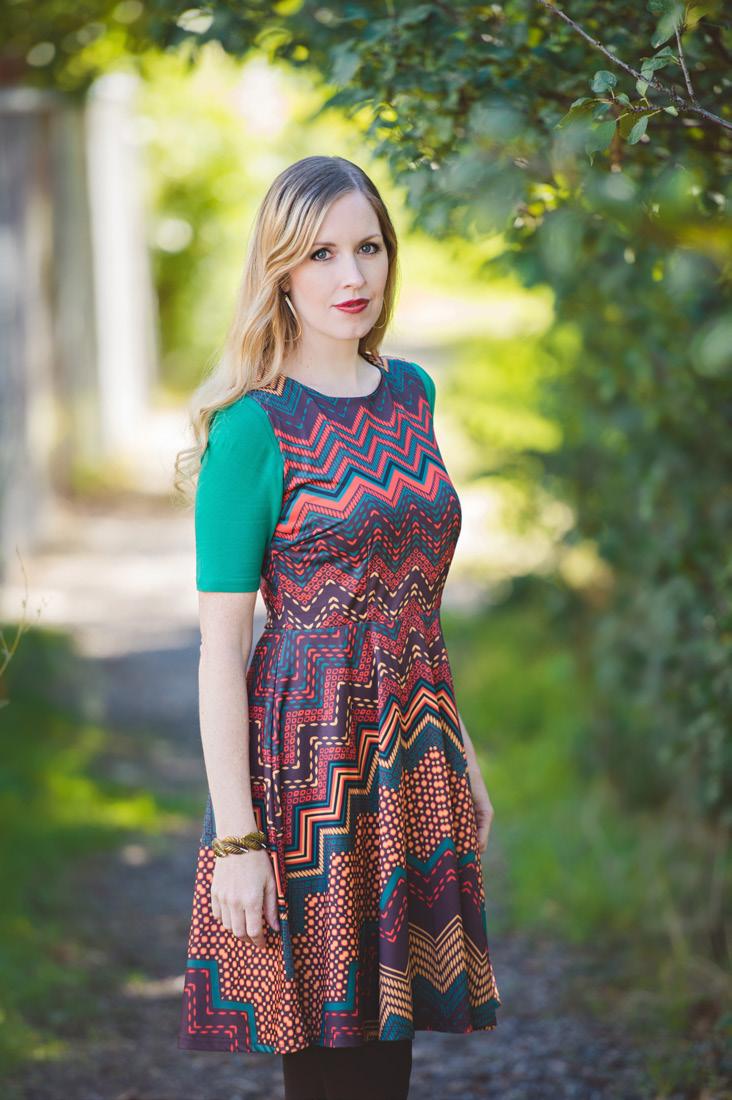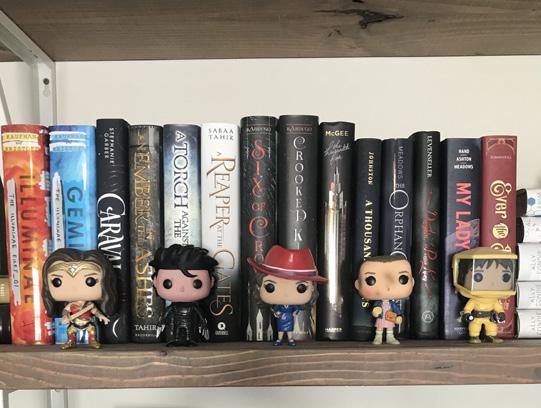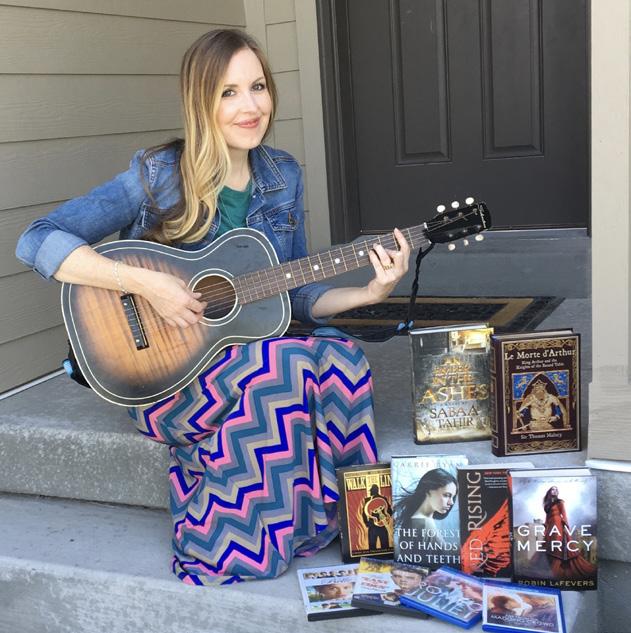
15 minute read
The Lure of Bones
WITH KATHRYN PURDIE
Interview by Gillian St. Clair Written by Juliet White
Advertisement
If you’ve ever crouched around a campfire with charred marshmallow adhered to the roof of your mouth, odds are good you’ve heard ghost stories about a woman dressed in white. Why white? Perhaps to better showcase bloodstains. Possibly this woman’s #lotd was bridal inspired, and now she’s stuck with it. Or maybe it’s because, if ghosts have already defied death, they’re not going to shy away from wearing white after Labor Day—haters be damned.
Urban legend springs to life—or death—in Kathryn Purdie’s new series, Bone Crier’s Moon. In this version, the woman in white is in possession of a pulse, but her job involves ferrying the dead to their final destination. P.S. Before she can fulfill that destiny, she must murder her one true love.
Purdie tempts us into a delectably dark world that marks a departure from the setting of previous novels. Her Burning Glass trilogy centered on Sonya, a magical empath, while Bone Crier’s Moon features a more elaborate magical system that revolves around bones. Despite the differences, Purdie dreamed up this new project while still working on her trilogy.
“When I was writing Burning Glass, I needed a myth Sonya referred to that would help her feel empowered,” Purdie explained. “I was researching Russian mythology and, on the same page, I came across these supernatural beings that you see in French folklore. They were called Les Dames Blanches—the white women. But it really means the women in white clothing. You see a version of this myth across almost all cultures.”
“With Les Dames Blanches, if a man is coming across a bridge at night and there’s a woman in white and he asks her to cross, she will ask him to dance. If he says yes, they will dance, and she lets him cross the bridge. If he says no to the dance, then

the bridge. If he says no to the dance, then she kills him. And that’s the folktale! I read that and all my writer nerves were on fire. I kept thinking about it over months. That’s when you know you’ve got to write something, when it doesn’t leave you alone.”
That premise provided the jumping off point for Purdie’s latest YA novel. “I kept thinking I’d want a teenage girl who feels justified in doing this—because I don’t want her to be evil,” the author said. “How can she justify killing a man? Why would she need to? Because the folktale doesn’t go into specifics on that. I finally decided that it would be a sacrifice she made in order to achieve a greater good: she needs to kill her one true love in order to protect the world.” But protect the world from what? One question spawned another. “In most cultures’ mythologies, bridges represent the connection between the mortal world and the world beyond. Why is she on a bridge like that?” Purdie mused. “Because she’s a ferrier of the dead. These women transport people to one of two places: a hell and a heaven. There’s one god that requires bone magic and then the goddess has a magic that’s more ambiguous. It’s light. The women are descendants from these gods. They’re
30 K CURIOSITALES not immortal—if they get killed, they die— but that’s how they get their power.”
Outsiders call them bone criers, but the women refer to themselves as Leurress. They live in groups called familles and two of Purdie’s three main characters, Ailesse and Sabine, belong to the same small famille. The third protagonist, Bastien, has the misfortune of being Ailesse’s one true love, a.k.a. the boy she must murder.
“I’ve written stories that never got published and this is the third time I’ve written a matriarchal society,” Purdie said. “Burning Glass even has one to a certain extent, because Auraseers are all women and are enslaved for that ability. I love Mists of Avalon and, in old mythology, you see really powerful goddesses. I want modern-day teenage girls to see themselves in those characters, to know that they’re innately powerful. They can create their own core values, embrace the power in them, and strike their own path.”
Purdie presents two disparate views of life as a Leurress by showing it through the lenses of both Ailesse and Sabine. “Ailesse starts out in the stronger position in the story. She’s like, ‘I am going to be the next leader of my famille. I’m ready for this. I believe in my own power.’ Sabine is questioning everything. She also feels pretty powerless.” Both girls agree on the importance of their role because the stakes are high. “If souls aren’t ferried, the ones that were meant to go to the underworld will eventually suck the life energy from the mortals. If they suck enough, it’ll kill a mortal’s soul. That’s why the Leurress need to ferry souls on the new moon,” Purdie revealed.
Ailesse and Sabine disagree on the morality of how they obtain their powers, which requires animal sacrifice. When the girls keep the bones from the animals they kill, they take on some of the traits of those creatures, which helps them to become better ferriers.
“They can only get three bones,” Purdie explained. “Ailesse has a peregrine falcon wing bone for speed because they’re the fastest bird. She can’t fly, but she can jump high and she’s incredibly fast. Sometimes [the Leurress] travel for a great bone like that of the Alpine ibex, a mountain goat—they’re excellent climbers. Ailesse has carved a pendant from the pelvic bone of the Alpine ibex. The Leurress have to ferry the dead on a land bridge that submerges into the sea. There are rocks, and it’s slippery, so that agility would really help her. The book opens when she’s trying to obtain a tooth from a tiger shark for her third bone.”
“I wanted some sea creatures but it’s tricky because most don’t have bones. A shark’s skeleton is made of cartilage. But there’s a mineral in teeth called apatite that’s the same mineral in bone, so I made that the fundamental requirement in my book. Basically an animal’s tooth can count as a bone,” Purdie said. “That way I could incorporate some sea creatures with cool abilities. Sharks have a sixth sense, and that’s the main thing Ailesse wants, but sharks can see well in the dark as well. You can get anything that that animal has, but it doesn’t change your anatomy—Ailesse is not going to be able to breathe underwater.”
On the other hand, Sabine feels very conflicted about what it means to live as a Leurress. “She was pressured by the matriarch of the famille to start acquiring bones and she has a strong aversion for killing, so she finally made herself kill something that she thought wouldn’t make her cry—a salamander. But she still was devastated. She wears a tiny salamander skull and feels ashamed of it, not only because she killed the creature, but because everyone has formidable bones like wolf bones, the matriarch has bear bones, and Ailesse does get that shark tooth. They have these really impressive hunts and all she has is this salamander skull. But we have Ailesse’s point of view in the story too, and she admires Sabine for that bone because a salamander can regenerate limbs, so it has the power to heal. That skill comes in handy.”
Purdie’s portrayal of a magic system based on animal sacrifice doesn’t mean she endorses it. “I don’t think it’s okay and I want readers to not think it’s okay, too. As an author, you’ll see that I address that. Ailesse changes a lot over the course of book one, and you’ve got characters that question along the way, so hopefully that’ll help the reader feel comfortable that they’re in good storytelling hands.”
“As the book progresses, the girls switch roles a tiny bit. Sabine has to become more violent to try and save Ailesse. Ailesse
is the heir to the famille and what she wants most is her mother’s love and approval, but her mother is cold and distant with her. So she’s driven to be the best Leurress there ever was. She doesn’t question the cost of it.” Ailesse’s attitude shifts after Bastien enters the picture. “Bastien saw his father die at the hands of a Leurress. He’s been trying to get revenge all of his life and find one of these Bone Criers. Ailesse comes to appreciate how this affected him and changed the trajectory of his life.”
“It’s definitely an enemies-to-lovers type of relationship evolvement for them,” Purdie admitted. “After they get past despising each other, Bastien understands the Leurress are not arbitrarily killing people. Ailesse believes she’s a good person. And she is doing something good by ferrying. Her people just shouldn’t be participating in blood sacrifice in order to do it. She starts to wonder, ‘Is there another way?’ That definitely comes to full fruition in book two.”
While you’re waiting for the sequel to Bone Crier’s Moon, Purdie recommends immersing yourself in Leigh Bardugo’s work. “She’s my favorite author. I haven’t read Ninth House yet and it’s probably super different than Bone Crier’s Moon, but I feel a kinship with Leigh in that we write dark, moody, fantastical things. I’ve read all of her Grisha Trilogy and Six of Crows books. I know she wrote Ninth House based off her experiences when she was attending Yale, but she’s put a whole fantastical twist on everything. I love Sabaa Tahir and Ember in the Ashes—I’ve read all of those as well. I’m reading the sequels to Stephanie Garber’s Caraval right now.”
However, the enduring literary love of Purdie’s life has always been mythology. “I remember going to my elementary school library and there was a shelf of the mythology of all these different cultures. I’d check them out, and that’s what I’d read over and over again. When people are like, ‘What was your favorite book growing up?’ I’m like ‘book’? I just read lots of mythology.”
Purdie grew up in a family that was supportive of the arts, in all their forms. “My dad was a publisher for a regional press for about 20 years. After doing that, he decided to write his own fiction. So I was raised by a very creative father. I’m from a big family and I’m the oldest daughter. I was born in the ‘70s so we had TV, but if you wanted to watch a movie you had to rent a VCR from the video rental store and rent a movie. In my very early years, we had to do other things for entertainment.”
“One of my most formative memories is that my dad would play records of beautiful music for us. He’d play the score to To Kill A Mockingbird by Elmer Bernstein.

He would tell us the story while we played the record, and my sister and I would act it out. It was this primitive family theater and it was very important for me in learning the power of story and how it can make you feel. Then I got a little older and I’d write plays and have the neighborhood girls come be in them. We eventually got a video camera and it was a bulky thing to record with—the camera would have to be connected to the VCR when you actually filmed—and we would make movies all the time.”
“In junior high, I started writing poetry for fun. It was dark poetry—imagine that! I was really shy,” Purdie recalled. “I got brave in high school and started acting. That’s when I developed a deep love for Shakespeare. Our school had an extensive drama program and that’s what I also ended up studying in college. My husband and I got to study at the Oxford School of Drama. We studied Shakespeare extensively. Shakespeare’s awesome because it’s poetry. Anytime you study poetry, it’s going to enhance your writing—not that I was even thinking of myself as a writer then. As an actor, you’re also studying character: their motivations, their objectives, their backstory.”
“I did write some short stories as a teenager and I was an extensive journal writer. I’d write 10 to 50 pages in my journal every night. It was mostly dictations of conversations I had with the boy I had a crush on. Nonetheless, I was developing the practice of regular writing. Journal writing helps you establish your voice, it helps you learn how to communicate feelings, so there’s a lot I took from that, even though it wasn’t creative fiction.”
It was only in her early 30s that Purdie set herself the goal of being published. “I hadn’t been able to act in a few years because, at this point, I’d had three children. My oldest, who had been our only child for six years, was a really easygoing child. We could always take her to rehearsal with us; she just adapted to everything. Then our next two were like, ‘I don’t think so. I’m going to fuss the whole rehearsal!’ I could have done more plays, but I choose to be with my children.”
Purdie’s perspective and needs shifted in 2009, after she donated a kidney to her brother. “I went through a depression for the first time in my life. I found my short stories in the months following that, when I was still recovering emotionally. It wasn’t just a creative void. I had gone through this really massive thing and I was so happy to help my brother, but I was suffering at that time and I didn’t know how to express myself because I wasn’t acting onstage, and I didn’t write in journals anymore. For me, journals aren’t a private place. I’m like, ‘My grandchildren are going to read this one day.’ When I write fiction, especially fantasy, my emotion gets out there. I think all art is an expression of something that’s so beautiful, profound, deep, vivid or painful that it’s difficult to express in any other way.”
“Purdie actively cultivates a creative lifestyle and encourages others to do the same. “Embrace everything you can artistically. If you live near a college, they usually have art shows and theater. Surround yourself with art and step outside your comfort zone. Try listening to some classical music. Try watching a different kind of movie—a more artsy film. It’s going to help you have more empathy, broaden your worldview, and give you a richer life. For me, it’s just the way I live.”
You can find more information about Purdie’s books, including Bone Crier’s Moon, on her website at kathrynpurdie.com/ books.
Bone Crier’s Moon was released on 03/03/20.
1. An inspiring view: The main reason I write in bed most of the time is because my window has a gorgeous view of the Rocky Mountains. I’m a mountain girl through and through. 2. A cozy blanket: A good friend gave me a blue plaid blanket after my dad passed away three years ago. To me, it represents my dad giving me a big hug. He was a writer, like me, so I feel him cheer- ing me on when I’m wrapped up in this blanket. 3. Beautiful books and art: I love to be surrounded by lovely and inspiring art. I turn beautiful picture books and novels face out on my bookshelf, like this edition of Little Women, and I’ve hung up em- broidery from my daughter and a framed map of my world from Burning Glass that an international fan tea-stained for me. 4. Notebooks: for when inspiration strikes. I have a dedicated notebook for every book I write, but I also have lots of other notebooks handy for when sparks of new book ideas strike, and for lists of great words, character names, and books I want to read. I can never have enough notebooks! 5. My growing collection of Funko Pop! dolls: Ed- ward Scissorhands and Wonder Woman are my fa- vorites. Edward tells me to write tight or he’ll start cutting, and Diana tells me I can do hard things. 6. Vanilla Coke Zero, the best reading beverage I’m sensitive to caffeine, but I still need a kick to keep me going every day. 1-2 cans of Vanilla Coke Zero hit just the right spot. (Advertised by my puppy here, my loyal writing companion.) 7. Bookmarks: I keep them in every book, even after I finish reading. I’m especially thrilled when I get a bookmark designed specifically for that book. They’re happy pairs that should never be separat- ed! 8. My bulletin board: I change it up every few months to keep me working hard and inspired. Right now it has my hand-drawn map of the world in Bone Crier’s Moon; a couple art cards with mo- tivating quotes; a picture of me and my dad; and note from my editor with her own artsy lettering of the word, GREAT; a ribbon from an awards cer- emony where I was a finalist; and an encouraging letter from my daughter. 9. My guitar: This vintage three-quarter size guitar is my favorite of the guitars in my house, and I use it to write songs for each of my books. Music is super important in helping me connect with the mood and tone of a story. 10. My kidney pillow: When I donated a kidney to my brother in 2009, the hospital gave me this kid- ney pillow. Now I use it to prop up my head when I write in bed, and I sleep with it beside me every night. Recovering from donating a kidney was very difficult for me, so this pillow also reminds me I can do hard things.















